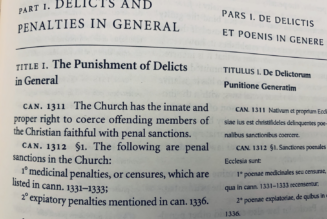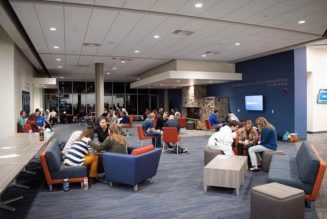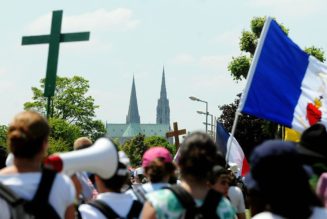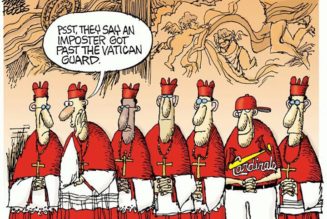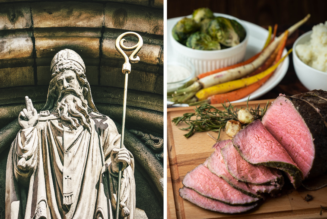Hey everybody,
Today is the great, good, and glorious feast of all saints, one of the most beautiful days on the Church’s calendar.
I am genuinely excited for this feast, in which we thank God for the “great cloud of witnesses” with which we are surrounded.
Of course, if today is All Saints, that means yesterday was Halloween. That means that in the portion of the day when I’m usually writing my newsletter, I was taking the Flynn children trick-or-treating instead.
So if The Tuesday Pillar Post is a bit short today, well, the Flynn children took my newsletter writing time. Take it up with them.
The news
Seven months ago, Fr. David Morrier, TOR, once chaplain of the Franciscan University of Steubenville, pled guilty to one count of sexual battery, in a plea bargain that came after he was accused of grooming and sexually assaulting a student.
When he was convicted, university and province officials said they had not received any allegation of sexual misconduct until 2015 – when Morrier was removed from ministry at the Texas parish where he was serving as a parochial vicar.
But The Pillar wrote at the time that something didn’t add up about that claim — that if the university and province hadn’t received abuse allegations until 2015, it didn’t make sense that Morrier was abruptly removed from the university in 2013, or reportedly barred from its campus in 2014.
Well, new details in the Morrier case became available last week, in the form of a July lawsuit drafted during settlement negotiations between the priest’s victim and the university, and sent to The Pillar, and several other journalists.
The lawsuit alleges a grave pattern of grooming, manipulation, coercion, and abuse which has been described to me as “demonic.” It also alleges points at which university officials, leaders, and staffers could have intervened to stop a pattern of sexual and spiritual abuse, and didn’t do so.
The suit calls into question claims from the university and the province about when they knew what they knew — it alleges that university and provincial officials were informed of Morrier’s abusive conduct well ahead of 2015, despite claims to the contrary.
The Pillar asked both the university and the province last week whether it has investigated allegations that some university priests failed to act on direct reports of abuse — including the university’s current chaplain.
While The Pillar’s questions were about how the allegations have been handled – and not specifically about the legal settlement – both university and province said they would not comment because the legal settlement is confidential.
Read about this very serious story here.
For what it’s worth, it seems likely that the university and province will need to answer someone’s questions — if not those of the media, potentially those of the Holy See, as the allegations made in the lawsuit are quite serious, and there is not yet clarity about whether they’ve been investigated at all. There will be more to this story – more documents have emerged in recent days – and there will be more questions — and alumni, students, parents, and others waiting for answers.
—
Speaking of Steubenville — we reported earlier this month that Steubenville Bishop Jeffrey Monforton was facing a Vos estis lux mundi investigation, on charges of mishandling allegations against a diocesan priest.
Well, make that two investigations. The Pillar reported Monday that Bishop Monforon is now facing a second Vos estis investigation, related to a different set of allegations in the diocese.
In addition to those, the bishop is also facing criticism for his handling of the case of Henry Foxhoven, a Steubenville priest convicted in 2018 on charges related to impregnating a teenager in the same year.
And a Pillar investigation has discovered some especially difficult news for Monforton and other diocesan officials. In 2017, Catholics in Steubenville complained that Foxhoven had been seen behaving inappropriately – and in violation of diocesan policy – with a teenager. The diocese suspended him for a week, said he’d begin counseling, and returned him to ministry.
In 2018, when Foxhoven was arrested, local media reported that the diocese again said that Foxhoven had begun counseling the year prior — in fact, before he was returned to ministry.
The problem? The Pillar discovered that, in fact, it took the diocese months to arrange a counselor for Foxhoven, and the priest did not actually see the counselor until September 2018 — the month before he was arrested for impregnating a teenager.
That situation may well turn into another Vos estis investigation in Steubenville.
In the meantime, of course, the U.S. bishops’ conference is expected to have a consultative vote in two weeks on whether to merge the Steubenville diocese into its neighboring Diocese of Columbus.
You can read all about that, and the investigations in Steubenville, right here.
We cover often at The Pillar the ongoing elements of the Church’s sexual abuse scandals, and the effectiveness of the reform measures introduced by Pope Francis on that front.
We don’t always – or often enough – cover the healing.
But this interview with Fr. Daniel Griffith of St. Paul and Minneapolis covers efforts to bring healing through the work of restorative justice.
What’s that?
“Restorative justice is a philosophical and practical approach to harm….fundamentally about needs and obligations. When a person or a community has been harmed, restorative justice asks: what do they need to help heal from the harm they have experienced? Correspondingly, what can the perpetrator of harm or the community do to help repair the harm and restore justice?”
Never heard of it? You’re not alone.
Fr. Griffith points out that:
“One of the significant challenges with restorative justice is overcoming the knowledge gap – many people don’t know what it is or prejudge it. I was in this camp. When I first heard the term I quickly thought, ‘This sounds new age, fuzzy, and ethereal.’ The reality is the opposite. Restorative justice is very effective at repairing harm and highly adaptable to different circumstances.”
Can restorative justice really bring healing to victim-survivors in the Church? Can it help others too? Can it even “play an important role in repairing the relationships among priests and bishops in the United States?”
Fr. Griffith says yes. Find out why right here.
—
Next, The Pillar interviewed this week Cardinal Michael Fitzgerald, longtime head of the Pontifical Council for Interreligious Dialogue. The cardinal had a lot to say about Islam, and the common work among Christians and Muslims for “moral values and justice and peace.”
As a long-time missionary priest in places like Sudan, the cardinal also has an interesting personal story.
Here’s what Cardinal Fitzgerald told The Pillar.
—
In Hong Kong on Monday, the trial of Cardinal Joseph Zen resumed, with defense attorneys arguing that the charges against Zen should be dropped. The cardinal is facing criminal conviction for his work organizing a humanitarian defense fund for pro-democracy protesters in Hong Kong.
Zen was arrested on serious national security charges, but is only facing trial on lesser crimes, and would face a fine, not prison time, if he is convicted. But at the same time, Hong Kong officials have said recently they will enact new crackdowns on anti-Beijing and free speech protesters in Hong Kong.
Read about Cardinal Zen’s trial, right here.
—
Poland’s bishops raised questions last week when Russia’s ambassador to Poland was invited to a reception at the Vatican embassy in Warsaw. The bishops asked the apostolic nunciature to explain the invitation, after Polish media reported that government officials were “dismayed” by the nunciature’s invitation, and allegedly concerned about the Vatican’s position on the war in Ukraine.
But the row turned out to be over very little, at least according to the Polish bishops’ conference, which said that the Russian ambassador’s presence was nothing more than a routine meeting of numerous ambassadors to Poland, at which nothing of substance was discussed.
Well indeed.
Read about the latest in Polish-Russo-Vatican diplomatic circles.
—
The bishops close the door
As I mentioned above, the U.S. bishops will meet in Baltimore in two weeks for the plenary assembly of the USCCB. Of course, The Pillar will be there — much of our coverage between now and then will break down the bishops’ agenda for that meeting.
But it’s worth noting already that a once-temporary change to the bishops’ schedule will become, it seems, a continuing custom for the USCCB – and probably with good effect.
The days before the USCCB plenary meeting begins are packed at the conference hotel with smaller meetings of conference committees, working groups, task forces, and often the board meetings of other Catholic groups and projects which take advantage of the fact that hundreds of bishops have descended upon Baltimore.
Those meetings bring with them staffers, consultors, experts of various kinds, and, inevitably, vendors — in short, they can be a bit hectic. And they used to pour right into the public sessions of the bishops’ meeting itself, with scarcely time for anyone to take a breath as things got started.
Well, the conference has added time to take that breath. Last fall, as the bishops gathered for a vote on the much-debated Eucharistic coherence document, the conference’s administrative committee tweaked the meeting’s schedule. They began things with a closed-door period of prayer and fraternal conversation, an executive session the bishops said was focused on actual engagement — with God, and with each other.
That closed-door session has been credited with the near-unanimous passage of a Eucharistic coherence text that seemed to represent the consensus of the conference.
So the bishops are doing it again. The fall meeting this month will begin, again, with a closed-door executive session focused on prayer and fraternal conversation.
Now, as a journalist, of course, I’d like to have more access, not less — more knowledge of what’s being said, especially on important issues of public interest for Catholics.
But anyone observing the bishops’ meetings can see that the presence of television cameras changes the tenor of the meeting — that there are bishops during the ordinary public sessions who seem disinclined to say anything, and others seemingly keen to be seen saying about as much as they can. That doesn’t often allow for healthy conversation. And as a Catholic, I want bishops to be able to talk with each other.
To be frank, I’m not sure what the right balance is between an increase in executive sessions – aiming to foster unity and fraternity through prayer and candid conversation – and the genuine need for public accountability in the life of the Church.
I’m not sure conference officials do either.
It would be a big change if more of the conference’s important deliberations were put behind closed doors, so that the public session of the meeting became little more than a performative bit of theater ahead of the real work.
It would also be unfortunate if an effort to foster fraternity with closed door meetings morphed into the kind of opacity that breeds problems in any organization — the kind the bishops committed themselves to end back in 2018.
I suspect the conference will have to think about how to balance its own commitment to transparency with the good it perceives in meetings without an audience. It’s possible that distributing redacted minutes might help, or permitting reporters, but not cameras, under something like the Chatham House Rule.
In the meantime, we’ll pay attention to the new approach to episcopal conversation at the USCCB. It may well bear fruit, as it seems to have done in 2021. But we’ll also ask how it fits with the bishops’ commitment to transparency, and the importance of their openness in the life of the Church.
I’m not saying we’ll have our ears pressed against the keyholes, of course. But I am saying we’ll be hanging around, and The Pillar is the best place to stay informed on all things USCCB.
We are planning a party in Baltimore — and if you’re a friend of The Pillar, you’re invited.
Friends of The Pillar are invited to Todd Conner’s Bar in Baltimore, on Nov. 16 at 7 p.m., the last night of the USCCB’s fall meeting.
We’ll tape a live show of The Pillar Podcast, unpack the meeting, and have a rootin-tootin good time.
We love taping dive bar shows — and for this one, The Pillar’s got the whole bar to ourselves, for what promises to be a great night.
Bishops drink free, of course, but the rest of you will have to pay for your drinks. Still, it’ll be a time — and a better one if you’re there.
—
Starting Seven
A lot of you have begun this month reading Starting Seven, The Pillar’s daily news roundup from Luke Coppen.
People have written to tell me that Starting Seven is the Catholic daily news skim they’ve been looking for, that it’s exactly what they want each morning, and that it keeps them sounding informed when they get to the chancery or the parish in the morning.
Good. Starting Seven is fantastic, and you should be reading it. All informed Catholics should. Here’s how to sign up for it.
But starting this week — like on Thursday — you’ll (mostly) only get Starting Seven if you’re a paid subscriber to The Pillar. So if you love Starting Seven, subscribe – or upgrade your subscription – right here. Today is the day. Do not delay:
(Except, if you want Starting Seven, and you can’t afford to sign up, or if you already subscribe, but you want Starting Seven to go to your wife or husband’s email address too, or something like that, just email us — we’ll take care of it.)
‘Signed with the cross’
Friend of The Pillar Sara Perla suggests this reading for All Saints Day, written in 2006, by Fr. Hugh Vincent Dyer, O.P., a chaplain at The Catholic University of America:
The saints have been most profoundly signed with the cross when they’ve received the fruit of its sorrowful and victorious mystery, when they’ve received the Body and Blood of Christ in the Holy Eucharist. The Eucharist gives us a share in the life of the Trinity, the love shared among the Father, Son, and Holy Spirit. We were made to love and Christ’s love empowers us to love in union with God who lives to love.
And:
The Church formed by the Eucharist is the friendship of God with his saints. This friendship transcends space and time and so the saints care for us even now. Saints touch the lives of other saints not only through proximity, but in other ways.
St. Charles Borromeo carried on his person a miniature portrait of the English martyr and Bishop St. John Fisher. Fisher’s portrait gave St. Charles strength in dealing with Italian noble families and in instituting reform. St Urho of Finland, whose feast is March 16th, drove a plague of grasshoppers out of Finland. The grasshoppers then flew to Ireland where the snakes came out to eat them. In turn, St. Patrick expelled the snakes from Ireland.
As we strive for holiness we ask the saints intercession, celebrate what God has done in them, read their lives and writings, join their religious communities and imitate their virtues. This is the great bounty of the Eucharist!
The French novelist Léon Bloy wrote: “There is but one sadness—not to be a saint.” Settling on not being a saint is like fame, it lasts only a moment. The effects of the cross signed on our hearts lasts into eternity while still producing fruit in history.
And here are three Flynn children, preparing last night for today’s All Saints Day parties:
Please be assured of our prayers. And please pray for us. We need it.
All holy angels and saints, pray for us!
In Christ,
JD Flynn
editor-in-chief
The Pillar
Join Our Telegram Group : Salvation & Prosperity



